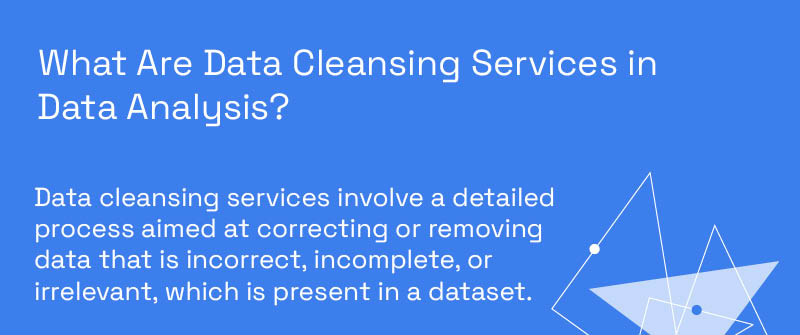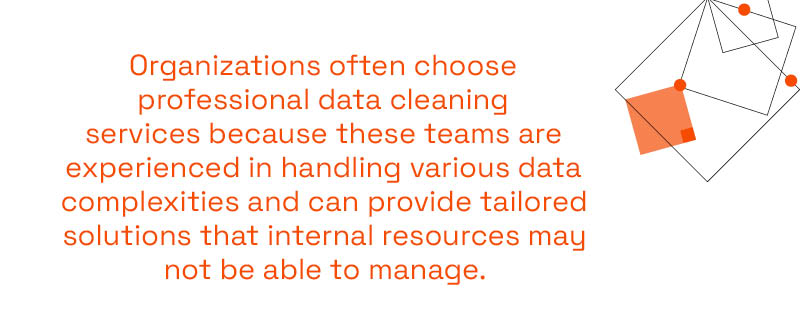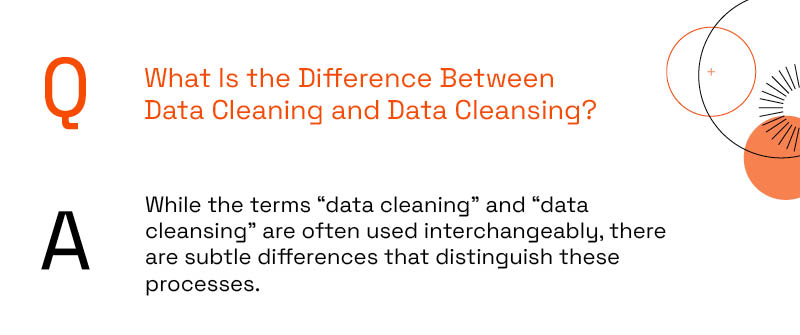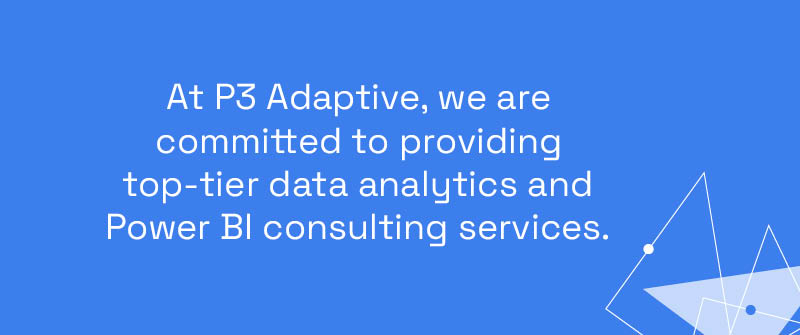
Introduction to Data Cleaning Services
In today’s data-driven world, the quality of your data significantly impacts your business decisions and, ultimately, your success. Data cleaning and data cleansing are critical processes that ensure the accuracy, consistency, and reliability of your data. These terms often intertwine but focus on slightly different aspects of preparing data for analysis. By employing effective data cleaning services, companies can transform their raw data, which may be cluttered with inaccuracies, into high-quality information ready for strategic decisions.
Data cleaning services are essential across various industries, from healthcare, where they ensure patient records are accurate and up-to-date, to retail, where they help in analyzing consumer behavior more effectively. At the core of these services is a suite of tools like Microsoft Power Query, which aids in streamlining the data transformation process. This tool is integral to Power BI consulting, helping businesses cleanse their data efficiently and preparing it for deeper analytics and insights.
As experts in data analytics consulting, we understand the challenges businesses face with disorganized data. Whether it’s duplicate records, inconsistent formats, or outdated information, our team at P3 Adaptive is equipped to handle it all. Our goal is to make data cleansing accessible to all businesses, irrespective of the initial quality of their data. Let’s explore how data cleansing services and data hygiene services can rejuvenate your data environment and why choosing the right partner to outsource data cleansing services can set the foundation for reliable data and insightful data-driven strategies.
What Are Data Cleansing Services in Data Analysis?
Data cleansing services involve a detailed process aimed at correcting or removing data that is incorrect, incomplete, or irrelevant, which is present in a dataset. These services encompass a range of activities, from rectifying typographical errors and inconsistencies to deleting unnecessary data, ensuring that the final dataset is both accurate and useful for business applications.
There are several types of data cleansing services available in the market, each tailored to address specific issues within a dataset. For example, some services focus on standardizing data formats, while others prioritize identifying and eliminating duplicate entries or enriching data by filling in missing values. The choice of service largely depends on the specific needs and the data quality objectives of the business.
The benefits of utilizing leading data cleansing companies are manifold. Firstly, they enhance the accuracy of your data analytics, leading to more reliable business insights and better decision-making. Clean data also facilitates improved operational efficiency, as it reduces the time and resources spent on correcting data errors during analysis. Moreover, high-quality data can significantly improve customer satisfaction by ensuring that customer interactions are based on accurate and timely information.
At P3 Adaptive, we leverage powerful Microsoft tools like Power Query in our Power BI consulting services to perform advanced data cleansing tasks efficiently. Our expertise allows us to not only cleanse your data but also to transform it into a strategic asset that can drive business growth and innovation. Whether you are dealing with disorganized data sets or you need a robust system for ongoing data management, our data cleansing services are designed to meet your business needs effectively.

Who Performs Data Cleaning?
Data cleaning is a crucial task that is typically handled by a team of data professionals. These individuals possess specialized skills in data analysis, data management, and software tools that are essential for ensuring data quality and reliability.
The roles and responsibilities in the data cleaning process can vary significantly depending on the organization and the complexity of the data. Generally, the team includes:
- Data Analysts: These professionals scrutinize the data for inconsistencies, inaccuracies, and outliers. They employ analytical skills to determine the roots of data issues and to formulate solutions to correct them.
- Data Engineers: They play a critical role in building and maintaining the architecture needed for data cleaning, including databases and processing systems. Data engineers implement the solutions designed by data analysts to clean and restructure datasets.
- Database Administrators: Responsible for the overall management of data storage systems, database administrators ensure that the data remains secure, accessible, and stored efficiently.
- IT Specialists: These team members provide the necessary technical support to maintain the software and hardware that data teams rely on for their cleaning processes.
At P3 Adaptive, we have a dedicated team of data professionals equipped with the latest Microsoft tools and technologies, such as Power BI and Power Query, to ensure that your data cleaning tasks are performed efficiently and effectively. Our team not only focuses on cleaning your data but also ensures that it is optimized for your specific business needs.
Organizations often choose professional data cleaning services because these teams are experienced in handling various data complexities and can provide tailored solutions that internal resources may not be able to manage. Choosing the right data cleansing solutions involves considering factors like the provider’s experience, the technologies they use, and their understanding of your industry. This ensures that you not only cleanse your data but also enhance its quality to support your business objectives effectively.

What Are the 5 Concepts of Data Cleaning?
Understanding the foundational concepts of data cleaning is essential for ensuring that your data is of the highest quality. These concepts are the pillars upon which effective data management strategies are built. Here’s a breakdown of the five key concepts:
- Accuracy and Completeness: This involves ensuring that the data accurately represents the real-world values it is supposed to reflect and that no critical pieces of information are missing. Accuracy checks might involve comparing data entries against reliable sources, while completeness checks ensure all necessary data is captured and recorded.
- Consistency and Conformity: Data should be consistent across the dataset, and it should conform to a predetermined set of rules or patterns. This includes standardizing data formats, using the same units of measure, and ensuring that similar data types across different fields follow the same formats.
- Duplication Elimination: Removing duplicate data entries is crucial to prevent the same information from being counted multiple times, which can lead to skewed analyses and decision-making. Identifying and merging duplicates requires sophisticated matching algorithms, especially in large datasets.
- Integrity and Validation: Data integrity ensures that data is accurate and reliable throughout its lifecycle, and validation involves checking that the data meets specific criteria or business rules before it is used in analysis. This might include range checks or format validations to ensure data types are appropriate for their intended use.
- Relevance and Timeliness: Data must be relevant to the current analysis needs and should be updated or purged accordingly. Timeliness refers to ensuring that the data is up-to-date and reflects the most current situation or environment.
At P3 Adaptive, we emphasize these five concepts in our Power BI consulting services, employing Microsoft tools like Power Query to ensure that data cleaning is not only thorough but also integrates seamlessly into broader data management and analytics processes. By adhering to these principles, we help businesses maintain a solid data foundation, which is crucial for achieving accurate and actionable insights.
What Is the Difference Between Data Cleaning and Data Cleansing?
While the terms “data cleaning” and “data cleansing” are often used interchangeably, there are subtle differences that distinguish these processes. Understanding these distinctions is crucial for businesses looking to improve their data management practices.
Data Cleaning typically refers to the process of detecting and correcting (or removing) corrupt or inaccurate records from a dataset. This process involves identifying incomplete, incorrect, or irrelevant parts of the data and then replacing, modifying, or deleting this dirty data. Data cleaning can also involve actions such as deduplication and record matching.
Data Cleansing goes a step further to not only address errors but also harmonize and standardize data. This process includes additional tasks such as adjusting data from various sources to be consistent and compatible. Data cleansing might involve more comprehensive measures such as data enrichment, where data is supplemented from other sources, and complex data transformations to ensure uniformity across datasets.
In practice, both processes aim to improve data quality, but data cleansing might be considered a more extensive clean-up effort that prepares data for more intricate analytical tasks. For example, in healthcare, data cleaning might involve removing duplicate patient records, whereas data cleansing could involve ensuring all patient records are consistent with current medical coding standards, thus making them useful for detailed analytical processes like predictive modeling.
Real-world application examples further illustrate the differences:
- A retail company may use data cleaning to remove outdated entries from its customer database, such as old contact details. In contrast, data cleansing would involve not only updating or removing these details but also standardizing address formats and enriching the database with additional demographic information from third-party sources.
- In finance, data cleaning could be focused on correcting transactional errors, whereas data cleansing would also include validating and aligning the data across different systems to support consolidated financial reporting.
At P3 Adaptive, our Power BI consulting services utilize Microsoft technologies like Power Query to efficiently manage both data cleaning and data cleansing tasks. By choosing the appropriate level of data preparation, businesses can significantly enhance their data quality, ensuring it is not only error-free but also uniformly formatted and enriched for advanced data analysis.

Enhancing Data Quality with Professional Data Validation Services
In conclusion, the importance of investing in data quality through professional cleaning services cannot be overstated. High-quality data is a fundamental requirement for any business looking to create a data analytics strategy decision-making. Data cleaning and data cleansing services play a pivotal role in ensuring that data is not only accurate and error-free but also consistent, relevant, and timely.
Key takeaways from our discussion include the understanding that data cleaning is essential for correcting raw data, while data cleansing involves deeper processes such as data enrichment and standardization, making the data more valuable for complex analyses. Both processes contribute significantly to data quality, which in turn supports business intelligence, enhances customer satisfaction, and drives operational efficiency.
Businesses must recognize the value of these services and consider both free and paid solutions to determine which best meets their needs. Free services can be a good starting point for small projects or companies with limited budgets. However, paid professional services are often more comprehensive, providing tailored solutions that include ongoing support and advanced tools that free services typically do not offer.
Choosing the right data cleaning service involves understanding your data needs and business goals. At P3 Adaptive, we are committed to providing top-tier data analytics and Power BI consulting services. Our team of experts uses state-of-the-art Microsoft tools to ensure that your data cleaning and data cleansing needs are met with the highest standards of quality and precision.
Whether you are just starting with a disorganized data set or looking to refine and enhance existing data for better analytics, partnering with a professional service like ours can transform your data into a powerful asset for your business. Reach out to us today to get your data project started, and let us help you turn your data challenges into opportunities.

Ready to Get Started?
Ready to take control of your data and transform it into a strategic business asset? Don’t let poor data quality hold you back from achieving optimal business outcomes. At P3 Adaptive, our team of data experts is equipped with the most advanced Microsoft tools, including Power Query and Power BI, to help you cleanse, refine, and leverage your data effectively.
Start your data project with us today, regardless of the current state of your data. Whether you’re dealing with inaccuracies, inconsistencies, or outdated information, we have the tools and expertise to turn your data challenges into valuable insights.
Join the many businesses that have already benefited from our professional data cleaning and data cleansing services. Contact us now to schedule a consultation or to learn more about how our services can be tailored to meet your specific needs. Let P3 Adaptive be your partner in navigating the complex landscape of data management, helping you to make smarter, data-driven decisions that propel your business forward.
Contact Us Today – Unlock the potential of your data with P3 Adaptive’s expert services.
Get in touch with a P3 team member